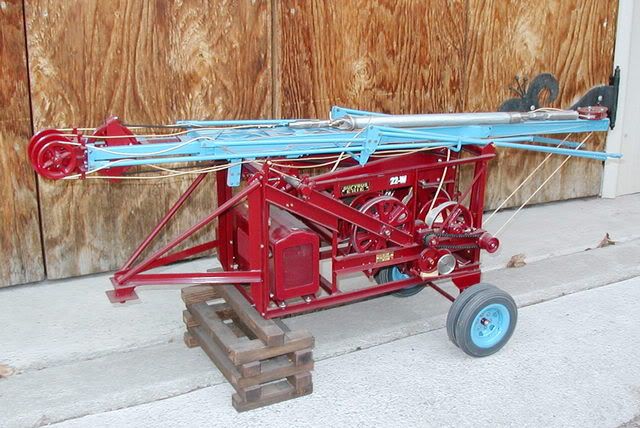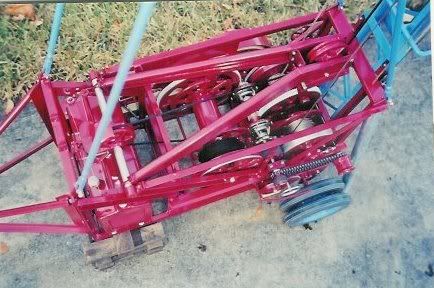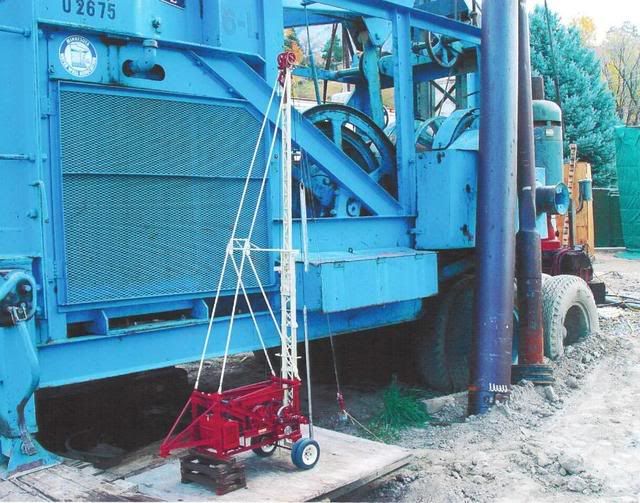Oldmechthings
Well-Known Member
- Joined
- Jan 10, 2008
- Messages
- 153
- Reaction score
- 12
The city where I live gets the majority if its water from wells, and the growing population requires more wells. Several years ago the city let a contract to drill a well in the corner of a city park just a little more than a block from our home. I have this problem of being attracted to machinery like iron to a magnet, so I had to go investigate the ruckus. It only took one trip to become acquainted with the owner operator Robert Perry. He worked alone and enjoyed having visitors like myself come every day to check the progress and chat for a while. Not only did I make a good friend, but I received one heck of an education on well drilling.
Then I have this second problem of wanting to build a model of every kind of old machine I see. So I started looking closely at the workings of the machine. Robert could see my interest, and suggested that rather than building a model of the #36-L machine that he was using that I build a model of a Bucyrus Erie #22-W, because he claimed they were the most popular well drilling machines in the world. Robert loaned me some operators manuals and parts books, and furnished me a key to his yard over in Spanish Fork City where he stored his fleet which included three 22-W machines, so that I could go measure and photograph as needed.
About 10 months later, the model was finished. That may sound quick, but you need to know that back then I did not limit myself to 8 hours a day or 5 days per week.

Right and left side views as it looks today.

Here is a view showing it erected in the driveway right after it was completed.

And another closeup looking down into the workings. The model has all the parts and functions of a full size machine. The only difference is that it is equipped with a variable speed electric motor rather than a gasoline engine. It will do everything the full size one will do. It would probably even drill a well, except the drill stem is so light it would be pretty slow going.

Oh, I need to tell you that when building the model I made double of everything and ended up with two models, one of which was given to Robert. Here is a picture of his little rig, set up next to his much bigger Bucyrus Erie #36-L that he was using to drill the well for the city.

A few pointers on the well he drilled: He started with a 30 inch casing and went down as far as he could drive it, then kept stepping down in sizes as he needed too. They stopped just short of 800 feet. It took about two years although that had not originally planned on that much time. Provo sets in the basin of lake Bonneville. An ancient lake at least equal in size to the great lakes today. Where he was drilling was close to the mountain and the material that he was going through was mostly silty stuff that over time, had washed down off the mountain into the lake. One day as I was visiting, he pulled up a soil sample from 300 feet and when he opened the sampler there was a perfect snail shell about as big as your thumb nail, except it was as soft as drywall mud. The formation had water in it, but being so fine it did not flow very fast. About all they could pump was 500 gallons per minute. So he put a 16 inch screen down the hole and started to develop it. The screen was a stainless steel pipe with very narrow slits, that would let silt through but not course sand. He put a rubber head on his drill stem that acted like a piston. It can be seen in the picture with his model. He spent several months pumping that thing up and down in the hole pushing water out and drawing silt in, and then bailing out the silt. This produced a cavern down in the hole, which provided more surface area for water to seep from. In order to keep the cavern from collapsing in he kept dumping a special processed course sand down around the screen. Would you believe three 18 wheel semi truck loads?. When he finished the well would produce 3500 gallons per minute. Just as a point of interest, the city figures they need a capacity of one gallon per minute per household. So that well should take care of 3500 homes.
Birk
Then I have this second problem of wanting to build a model of every kind of old machine I see. So I started looking closely at the workings of the machine. Robert could see my interest, and suggested that rather than building a model of the #36-L machine that he was using that I build a model of a Bucyrus Erie #22-W, because he claimed they were the most popular well drilling machines in the world. Robert loaned me some operators manuals and parts books, and furnished me a key to his yard over in Spanish Fork City where he stored his fleet which included three 22-W machines, so that I could go measure and photograph as needed.
About 10 months later, the model was finished. That may sound quick, but you need to know that back then I did not limit myself to 8 hours a day or 5 days per week.

Right and left side views as it looks today.

Here is a view showing it erected in the driveway right after it was completed.

And another closeup looking down into the workings. The model has all the parts and functions of a full size machine. The only difference is that it is equipped with a variable speed electric motor rather than a gasoline engine. It will do everything the full size one will do. It would probably even drill a well, except the drill stem is so light it would be pretty slow going.

Oh, I need to tell you that when building the model I made double of everything and ended up with two models, one of which was given to Robert. Here is a picture of his little rig, set up next to his much bigger Bucyrus Erie #36-L that he was using to drill the well for the city.

A few pointers on the well he drilled: He started with a 30 inch casing and went down as far as he could drive it, then kept stepping down in sizes as he needed too. They stopped just short of 800 feet. It took about two years although that had not originally planned on that much time. Provo sets in the basin of lake Bonneville. An ancient lake at least equal in size to the great lakes today. Where he was drilling was close to the mountain and the material that he was going through was mostly silty stuff that over time, had washed down off the mountain into the lake. One day as I was visiting, he pulled up a soil sample from 300 feet and when he opened the sampler there was a perfect snail shell about as big as your thumb nail, except it was as soft as drywall mud. The formation had water in it, but being so fine it did not flow very fast. About all they could pump was 500 gallons per minute. So he put a 16 inch screen down the hole and started to develop it. The screen was a stainless steel pipe with very narrow slits, that would let silt through but not course sand. He put a rubber head on his drill stem that acted like a piston. It can be seen in the picture with his model. He spent several months pumping that thing up and down in the hole pushing water out and drawing silt in, and then bailing out the silt. This produced a cavern down in the hole, which provided more surface area for water to seep from. In order to keep the cavern from collapsing in he kept dumping a special processed course sand down around the screen. Would you believe three 18 wheel semi truck loads?. When he finished the well would produce 3500 gallons per minute. Just as a point of interest, the city figures they need a capacity of one gallon per minute per household. So that well should take care of 3500 homes.
Birk




















![DreamPlan Home Design and Landscaping Software Free for Windows [PC Download]](https://m.media-amazon.com/images/I/51kvZH2dVLL._SL500_.jpg)











































